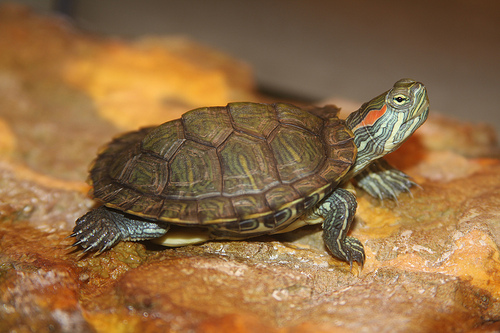Go a-slippin’ and a-slidin’ with red-eared sliders.
- Red-eared sliders are a turtle species native to water habitats of some southern areas of the United States and parts of north east Mexico.
- The scientific name of red-eared sliders is Trachemys scripta elegans and it is from the family Emydidae, the family of pond turtles.
- The carapace (shell) of red-eared sliders typically grows to be 12.5 to 28 centimetres (5 to 11 inches) in length, but they are sometimes longer.
- The shell colour of red-eared sliders varies from vegetation greens to dark greens depending on age, while limbs are usually green with yellow stripes, and behind each eye, a red or orange stripe can typically be seen.
- Red-eared sliders have been introduced to numerous areas across Europe, Australia, the Pacific Islands, Asia, South America and South Africa, where the turtle has become highly invasive in some parts, and it is listed as one of the most invasive species in the world.
Red-eared Slider
Image courtesy of Jim/Flickr
- Of all aquatic-based turtles, red-eared sliders are one of the most commonly chosen as pets, especially in America, as they are readily adaptable to new environments, however, they are banned in some countries.
- Red-eared sliders spend most of their time in the water, however, they have the need to bask in the sun to keep their body temperature up, as they cannot control their temperature themselves and they rely on external sources.
- Female red-eared sliders dig a hole in the ground to lay the two to thirty eggs that she produces at a time, that generally hatch between 59 and 75 or more days.
- A red-eared slider is identifiable by its abnormally long claws, red markings on its head, and its tendency to retreat into its shell by pulling its head in straight, rather than it bending horizontally.
- The diet of red-eared sliders typically consists of aquatic plants, fish, snails, insect young, and crustaceans, and they have a lifespan in the wild of up to 30 years, while those in captivity can live a decade or two longer.
Bibliography:
Red-eared Slider, 2009, National Animal Pest Alert, http://www.pestsmart.org.au/wp-content/uploads/2010/03/red-earedslideralert.pdf
Red-eared Sliders, 2015, Wikipedia, https://en.wikipedia.org/wiki/Red-eared_slider
Red-eared Slider Turtles, 2015, Brisbane City Council, http://www.brisbane.qld.gov.au/environment-waste/natural-environment/protecting-wildlife-brisbane/pest-animals-invasive-species/red-eared-slider-turtles







